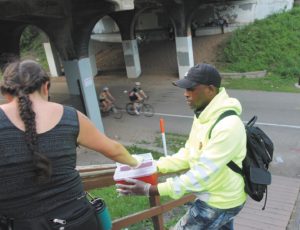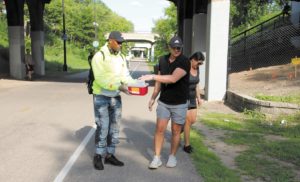Southside Harm Reduction Services working to distribute and pick-up syringes, provide naloxone, and reduce stigma for those using drugs

TESHA M. CHRISTENSEN
Luce Guillen (left) carefully places a used syringe into a container held by Michael Neil on Saturday, Aug. 24 during a clean up on the Midtown Greenway, Lake and Bloomington. Neil, a former user himself, says it is important to not just pick up the syringes, but to get to know the people who are homeless in order to know what they need. Plus, then he has some who save their syringes until the next time they see him, knowing he”™ll dispose of them properly. “I let them know we love them,” said Neil. “It”™s a reflection of where I come from, too.”
By Tesha M. Christensen
When Jack Loftus and Jack Martin saw a gap in services for safe injection equipment and more access to naloxone to prevent deaths from opioid overdose, they started Southside Harm Reduction Services.
Two years later, they”™re leading a crew of volunteers quietly working to distribute and pick up syringes in the Southside as they seek to reduce the stigma and judgement people using drugs experience.
“We recognize that drug use and the overdose crisis is incredibly complex and difficult to deal with, but we also know that everyone has the ability to make positive changes, from reducing stigma to picking up syringes to distributing naloxone themselves,” said Jack Martin. “And we know to embrace every positive change.”
Share the story of how Southside Harm Reduction began.
Jack: Southside was started by two people, both named Jack: Jack Loftus and Jack Martin (me). Both of us were working at the Native American Community Clinic (NACC) in South Minneapolis. Through our work at NACC we helped start a short-lived syringe service program that grew incredibly fast in the few months that it was open.Â
We learned that there was a huge need in the local Native community for safe injection equipment and more access to naloxone to prevent deaths from opioid overdose. We didn”™t want the people who were accessing the program to lose that service when the exchange closed at NACC, so we bought a cheap flip phone and started to hand out our number.Â
Back then people would text us or call us, and we would go deliver syringes, naloxone and other supplies to people after work or whenever we had free time. We were able to stay connected to many people who we got to know through the NACC exchange program this way.
We debated over what to call the organization for weeks and finally decided on Southside Harm Reduction Services.Â
We grew slowly at first but quickly exploded in popularity when the warm months came, thanks to word of mouth. The only advertising we ever did was putting up a few fliers in the dead of winter 2017-2018 on Bloomington Ave.Â

A Southside Harm Reduction crew looks for used syringes along the Midtown Greenway on Saturday, Aug. 24. Volunteers go out around the area several times a week. Go online to fill out a form requesting clean-up help.
We drew our inspiration from older local harm reduction programs such as Lee”™s Rig Hub, AccessWorks!, and Women With a Point. We had help and received advice from many others who were already experienced in harm reduction work at the beginning.Â
What is the mission and purpose of your group?
Jack: We strongly believe that a syringe exchange is more than just the syringes.Â
We believe healthcare and healing are intensely political, and people who use drugs or do sex work experience oppression in this way everyday.Â
Southside Harm Reduction is certainly about responding to the opioid overdose epidemic in a meaningful way, the racial disparities in OD deaths and HepC rates, and preventing HIV outbreaks ”“ it is also about promoting safety, community, and autonomy and agency over one”™s own health and body.Â

TESHA M. CHRISTENSEN
Co-founder Jack Lofter said, “People who use drugs experience so much stigma in their day-to-day lives … and that can have a real impact on people”™s health.”
Our mission is to fulfill those ideals for people who use drugs and their communities.Â
We do not aim to be just a service or a charity for people who use drugs. Our ultimate goal is for our organzation to be an avenue for people who use drugs to build community, to be empowered over their own safety, health and wellness, to be empowered politically and contribute to a cultural shift against stigma about drug use.Â
Our dream is to make comprehensive and culturally-relevant healing accessible to people who drink and use drugs, Indigenous people, people of color, LGBTQ people, people experiencing homelessness, people who do sex work, and anyone else who does not feel welcomed at existing institutions or feels they have to hide a part of themselves.
Why did you get involved?
Jack: Southside was started at the end of 2017 and early 2018 in the winter. We really took off in May 2018. We”™ve all been doing harm reduction work for longer than that. We got involved in this work because it was a glaring unmet need in the community.Â
When Southside started, there were four syringe exchanges in the Twin Cities Metro already, but they are not accessible to Indigenous people, and not accessible to many people in South Minneapolis in general.Â
We were and still are filling a huge gap in services.Â
Why is this work important?
Jack: At a base level the clean syringes reduce infections and the naloxone allow our participants to save people”™s lives and prevent overdoses ”“ which are both inherently important ”“ but we are also able to reduce the stigma and judgement people experience when accessing services.Â
People who use drugs experience so much stigma in their day-to-day lives, both from individuals and institutions and that can have a real impact on people”™s health.Â
Being able to offer nonjudgmental and supportive services ourselves and connect people to similar services helps remove barriers but also can reinforce the fact that everyone, including people who use drugs are important and deserve to be treated with dignity and respect.Â
How are you helping to solve the safety issue of needles on streets, etc. for local residents? Â
Jack: We don”™t think that anyone should have to worry about getting poked with loose syringes in their neighborhoods. It is certainly a valid issue, and as a syringe distributor we feel a responsibility to help make sure they are disposed of safely.Â
We take in used syringes from individuals, distribute sharps containers to our participants and people in the community so they can dispose themselves, and we have weekly street cleanup efforts.Â
We try and support community members who pick up used syringes as much as possible (this includes people who use drugs as well as people who do not or never have used drugs).Â
We understand that seeing syringes on the ground can be really jarring for people, and it poses a danger especially to children and pets.Â
It is important that people are aware of the reality that the risk is very low of catching any kind of diseases from a syringe. It is also important that people know the systemic reasons why people who use drugs might leave a syringe on the ground (such as it being illegal to have them on you, and it is tough to get rid of them quickly in any other way), and recognize that the amount of syringes that end up on the ground, compared to the amount of syringes being used in the area, demonstrates that nearly everytime people use a syringe they are disposing of it properly.Â
Its important that people remember that the people using drugs and using syringes are their neighbors, they”™re a part of your community, and above all else they are human beings and deserve the same love and compassion as everyone else. If we can un-do the stigma, when it is you or your loved one that is dealing with an addiction you”™ll be able to show them support and know how to be helpful. Â
How are you protecting Southside residents?
Jack: The people we work with are Southside residents. People who use drugs are our neighbors, friends, and family. People of any social class, race, and background are impacted.Â
Distributing clean syringes and naloxone prevents death from overdose and infectious disease outbreaks. Syringe exchange programs help support drug users and connect them to other services such as treatment or medical care.Â
A CDC study showed that people who access syringe services are five times more likely to access treatment services than people who do not access those same services.Â
Above all else, syringe exchanges work to help people and communities reduce the harms experienced by the drug war, the criminal justice system, racist and discriminatory housing and child protection systems, and to ensure that they have the tools and information needed to make their drug use practice is as safe as possible.Â
We meet people where they”™re at, and help people make improvements in their health and wellness, while reminding them they are loved and valued and deserve respect.Â
How can others get involved?
Sign up for our email list at southsideharmreduction.org!Â
We have packing parties every Thursday night, and two regular street clean-ups that everyone is welcome to attend. We also have new volunteers meeting once a month. We will be tabling at the Seward Cafe on Sept. 11. We”™ll be at Nicollet Ave. Open Streets on Sept. 22. Check out our website for more events as they come up!
One of the best way to support our work and get involved is to donate money. We are entirely funded by small grants and donations, and run completely by volunteers. Our most important resource is money used to purchase supplies.Â










[…] The Alley Newspaper was just dropped off today and had this front page article: […]